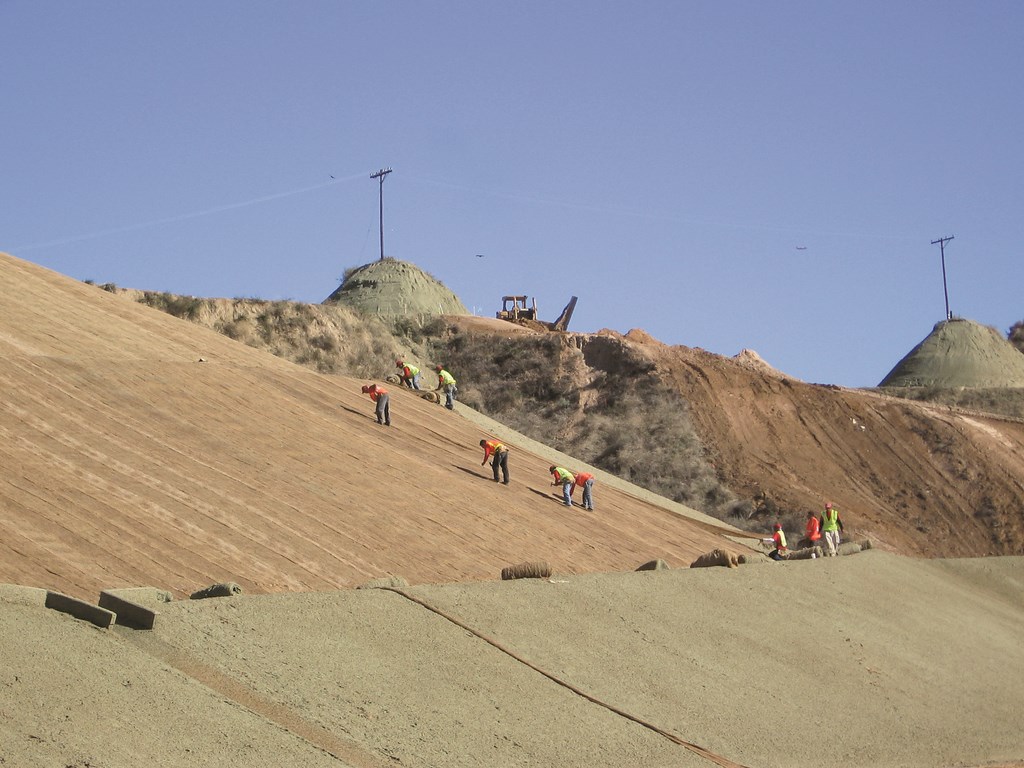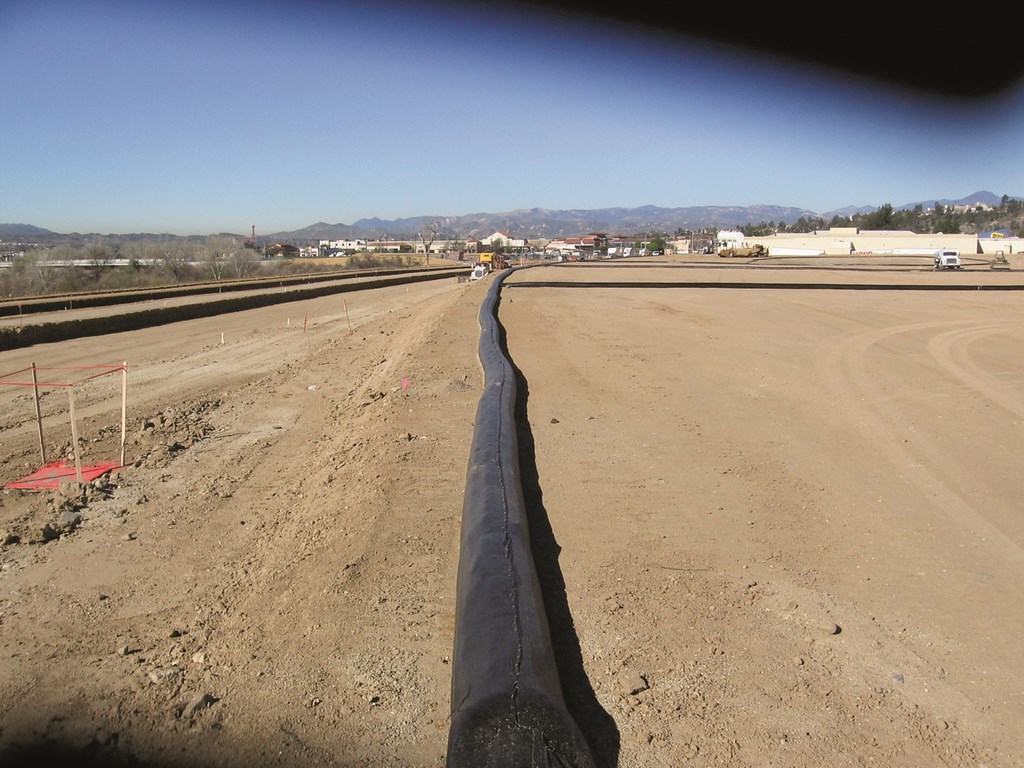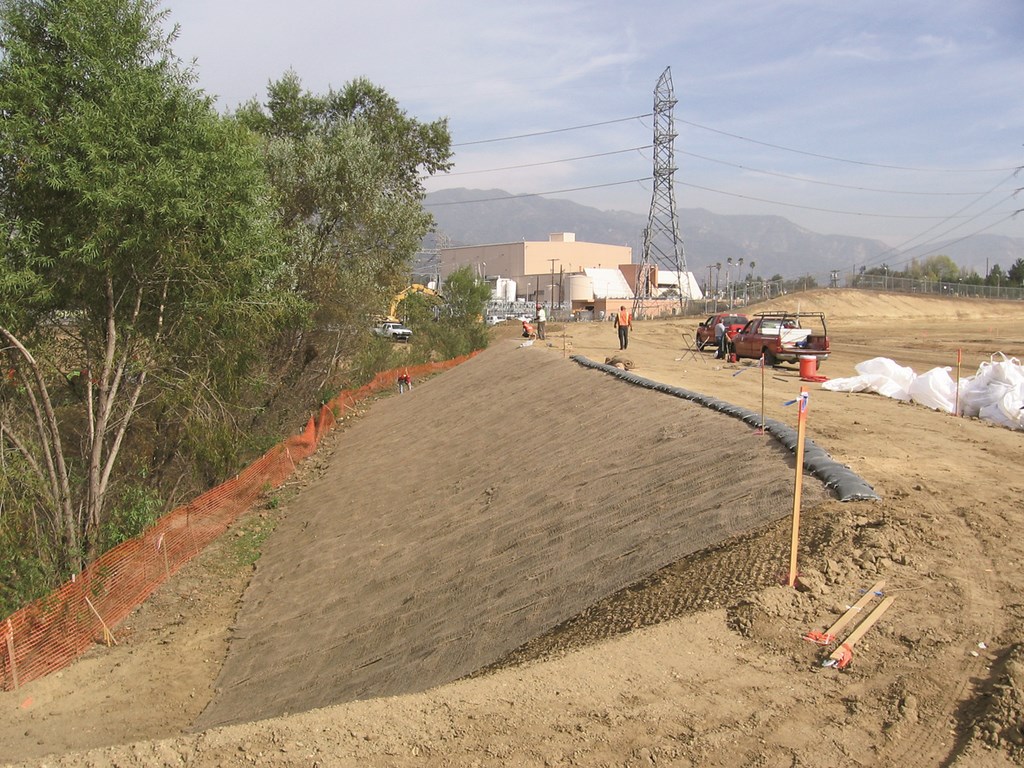Strengthening the Land

A rainstorm is a good thing: It gives us water, fills our lakes and streams, feeds our crops and landscapes and arguably makes our way of life possible. But if there’s too much of that good thing, it can also irreparably damage homes, roadways, curb and gutter, crops, landscapes and other elements of the environment, particularly when we’ve altered the topography to suit our own purposes.
The importance of erosion control and the need for including it in any land-altering project has been underscored through the years by numerous disasters, including landslides that have resulted in property destruction and even deaths. The principles of risk management should be sufficient to compel us, as professionals who shape the land, to plan for runoff and the consequences that might follow, especially in an environment where the government imposes significant fines for errors and omissions.
Even if those principles and the extraordinary impact of disasters and government fines aren’t sufficiently motivating, the direct of cost overruns or delays certainly should be.
Beyond economic and compliance issues and rules and regulations, however, we who contour the land need also to be thinking in terms of good citizenship: We all share responsibility for ensuring the ongoing health of our planet, whether it has to do with things we dump down our drains or the way we direct and redirect rainwater through the areas in which we live.
No matter whether it’s about preventing stormwater from polluting our waterways or protecting investments in land development, erosion control should be an essential part of and should be seen as a means of strengthening any land-development project, large or small.
SLIPPERY SLOPES
Erosion control is more complex than most people recognize. On its face, it’s about keeping mud from running into the streets or onto a property, so most people think about it only during good-sized storms. In reality, however, it’s about ensuring long-term site integrity, reducing the potential for major downstream costs, protecting the environment, complying with the legal requirements and maintaining what can be substantial investments in developed land.
Erosion control accomplishes all this through five basic functional elements:
[ ] Slope Protection. Maintaining the integrity of slopes is an essential, top-of-the-list consideration in developing any site adjacent to or including a slope.
This primary line of defense can be established in a variety of ways, whether by using biodegradable blanketing that will decompose and eventually become part of the slope; spraying on a light grow-in using hydromulch or hydroseed; protecting the surface with a plastic blanket and weighted superstructure to ensure limited (or no) future saturation; or impeding runoff with materials such as straw wattle that limit erosive forces and filter the flow.
| Of all the missions erosion-control specialists accomplish, the one with the most obvious significance is protecting slopes such as these during construction projects. Whether it’s maximum slope protection through application of an impermeable barrier (left) or slope management by laying biodegradable jute netting over a hydromulch base (right), the aim is to keep slopes where they belong despite the disturbances and intrusions of the construction process. |
Hydroseeding and hydromulching are quickly becoming mainstays in initial erosion-control efforts. The application of a light grow-in can provide a foundation for slope integrity or pad protection, expanding on techniques proved effective by Mother Nature. Slope coverage with either a grow-in seed or a bonded or stabilized fiber matrix increases the saturation capacity of a slope – or seals it with a natural product that can be built upon later.
In addition, the bases of slopes can become repositories through deployment of silt-fence lines that control silt debris and keep any solid runoff at the base of the hillside while still allowing water to migrate and eventually pass into the stormwater system.
[ ] Erosion Control. While there’s an obvious need for slope protection, less well recognized is the need to limit soil loss on level and (especially) developed pads in both wet and dry conditions.
Level areas certainly can be protected in much the same way as are slopes, but the functionality of the land tends to make “global,” large-scale protection approaches impractical in most environments. Instead, common techniques in these situations include the use of sand bags to create sealed perimeters; straw wattle to provide filtration and easier lot accessibility; and designated drainage pipes to clear water away from sealed-off lots.
|
Good Citizenship During the 1960s and early ’70s, we as a nation became keenly aware of the pollutants that were seeping (and in some cases pouring) into our rivers and streams. As a result, the U.S. Congress developed laws that set standards for clean water throughout the country and established a range of enforcement procedures. The Clean Water Act of 1972 is the enduring legacy of those times and has gone a long way in many areas toward protecting and enabling the restoration of America’s rivers and wetlands. Among the law’s wide-reaching provisions, it set the stage for the sort of vigilance about what happens to runoff and stormwater that have shaped erosion-control procedures to this day. The rules have raised awareness that runoff from developed areas carries all sorts of contaminants into streams, rivers and oceans – pollutants that not only harm fish but also create hazards that reach all the way to the top of the food chain. Much progress has been made, but increasing development is raising the level of concern about our waterways once again. This renewed concern positions landscape professionals to make a real contribution by establishing systems on site that control the movement and direction of water in ways that prevent the harm to be done by uncontrolled runoff. For more information on the significance of the Clean Water Act, visit www.americanrivers.org. There you will find the legislation’s text, a slide show and a list of 30 key concepts covered by the Act. — R.D. |
During dry periods, dust control can be achieved with the use of semi-saturation, water containment and/or (in some cases) surface blanketing.
[ ] Sediment Control. If erosion occurs, contractors must mitigate the damage on site by keeping sediment under control. This can be accomplished through use of impeding/filtering materials such as straw wattle, gravel bags and filter fabric, all of which reduce the waste carried through (or, worse yet, off) the site while still allowing water to migrate.
[ ] Drainage Management. The force of and direction in which water moves across a site can be critical to both erosion control and sediment control – as can the correct positioning of drainage-collection points.
Storm-drain systems provide the means for stormwater management once a development becomes a community and the community has completed its planting. Until that point, specific, targeted drainage paths and well-placed conduits are essential to prevent the undermining of the development or of individual lots within it.
[ ] Storm Response. Although the word is always used in this context, response is an unfortunate choice because it implies that “responding” to storm events with a series of actions after the fact is what is needed to manage a major rainfall event and mitigate any damage that might ensue.
In other words, it suggests that it is acceptable to manage the downstream effects of poor or inadequate erosion-control systems through clean-up, impediment placement, filtration and sediment control. But that’s short-sighted, because the response is best managed when it has been considered at the design-development stage – that is, before any work begins on the property.
It is the job of the erosion-control specialist to anticipate these issues and make certain that the response is both adequate and effective. Further, it’s clear that measures taken in response to a storm should not serve only to create secondary forces of destruction. If actions are not planned well ahead of any specific incident, in other words, fixing one problem often will create others down the line.
There are many situations in which combinations of these five functional elements come into play in land-alteration programs. In fact, virtually every well-planned site will call on planners to use a variety of methods, techniques and functional elements to get the job done effectively – and for the long-term.
THINKING AHEAD
A key point to remember in combining these elements is that each site is different and may have a number of issues that require addressing in different ways. The more diverse the topography, the more sophisticated will be the measures to be deployed.
It’s a balancing act, with much of what actually gets implemented being dependent upon the landscaping and irrigation and how these systems are designed relative to other elements on site, including structures. Relative positioning of these systems and structures and the distances between them will have much to do with which erosion-control methods will work best.
On a site where development is only just getting under way, for instance, an adjacent slope may not be outfitted with its landscaping for a considerable time to come. In such a case, the use of Visqueen or some other blanketing system can be put in place and left alone until work on the slope actually begins. That way – and assuming there aren’t any extenuating circumstances – there will be little chance of any kind of erosion.
| Both on slopes and on the flats, hydromulching and hydroseeding have become indispensable tools in erosion control. They provide a foundation for slope integrity that helps prevent damage when the rains come; on flat lots, they provide for dust control and increase the soil’s ability to hold and manage moisture. |
Cost evaluations are necessary in determining which systems should be deployed in this or any other specific case. The dollar figure is important, of course, but contractors also need to consider whether they are dealing with short- or long-term needs. In other words, you need to know if a temporary, lower-cost solution is appropriate – or if a permanent, costlier solution is what the situation requires.
The fact is, cost is often a driving factor in how erosion control is handled on site, and a number of projects are saddled with a desire on the part of developers to pay only for those things they see as being immediately necessary. The savvy ones also weigh issues on a pay-me-now-or-pay-me-later basis, taking into consideration the cost of production setbacks, site reconstruction or potential liability due to slope degradation in making their decisions.
Either way, these factors reveal why erosion control is sometimes a victim of a cost-cutting mentality, even among good development and contracting firms. And this is so even though establishing appropriate and efficient erosion control can actually be a cost-saving measure as the best possible assurance that a project will be completed on time and within budget.
SOIL’S ROLE
Beyond topography and the relative positions of slopes, structures and erosion-control systems, what’s going on with the soil is absolutely critical in determining cost-effective approaches to any site’s erosion-control program. From this perspective, there are primarily two types to consider – clay or sandy soil.
Clay soil will hold together much better than will sandy soil, but it has a lower saturation level and problems will arise when its saturation points are exceeded. When that happens, the damaging consequences can be dramatic. Clay soil also produces heavier sediment loads that will require more significant interaction to manage.
By contrast, sandy soils have a much greater saturation level that allows for much more absorption. In a significant storm, however, sandy soil will experience greater surface damage if it has not been properly contained or set up with appropriate drainage systems.
In areas with high water tables, of course, it doesn’t much matter whether you have clay or sandy soil because, either way, there’s less absorption before saturation occurs, and surface water will start running off quickly. In these cases, we institute more significant preventive measures (usually drainage systems) to avoid widespread problems.
| The consequences of inadequate site management can be dire – if, for example, a whole slope should give way and start moving. But those consequences can also be time-consuming, costly and utterly unnecessary, as when a lack of attention to a site’s basic needs leads to damage to slopes that must be corrected before other work can proceed. The aim of erosion control is preventative – and, ultimately, to save time, money and aggravation. |
A similar concern arises in areas where freeze-thaw conditions prevail and soil of whatever type becomes frozen and basically impervious to water. In these cases, most developers use aggressive approaches to drainage management, directing water to detention basins where it will do no harm.
Again, it is important to note that each project is different, and no matter what type of soils or special conditions exist – no matter what type of plan is developed – it’s possible to make mistakes that have the potential for creating significant problems.
This is why we focus on thinking through various possibilities and looking beyond the typical or obvious in developing our erosion-control plans: We know that if we address all the apparent issues of the site while also considering “what if” possibilities, we have a greater chance of successfully securing a site against any erosion or runoff problems.
Going forward, it’s our aim to determine how we will handle different erosion events (should they occur) and what will happen when the water starts to flow. On that level, we know it’s all about moving the water in the right direction and slowing it down enough that it’s less likely to do harm. If we do this, we can be reasonably assured any development or individual job site will be sound through all project phases.
IN THE KNOW
The good news is that erosion-control techniques and technologies have advanced to the point where just about any situation is manageable – so long, of course, as available methods and materials are properly used.
Take straw wattle, for example: If a lighter, less dense wattle is used or there is no trench dug under the wattle before it is laid, the cost will certainly be lower but its effectiveness in an erosion-control program will be minimal. Using a denser wattle supported by an adequate trench will be more expensive, but it will also be much more effective.
Of course, there’s no expectation that every landscape contractor will know about proper installation of straw wattle, but it would certainly be a good idea for those who shape the land to be aware of the need as well as the various approaches that may be used. It doesn’t take much to get nominally up to speed, and even a little bit of knowledge can make a huge difference if you’re thinking of these issues early in the design stage and can at least make property developers aware of the issues and needs.
| The approaches to slope protection, erosion and sediment control, drainage management and storm response tend to overlap one another and work together. What they’re mostly all about is controlling water, where it flows, how fast it flows, what it carries with it as it moves and how it can be kept from becoming an issue with the community around a site or a development. Whatever it takes – controlling a release point for pad drainage (top left), providing a high-volume containment area and sediment barriers (top middle left), setting up solid check dams to impede and filter runoff (top middle right), establishing simple sediment-control perimeters (top right), laying out grids of trenched-in straw wattle (bottom left) or protecting undisturbed land below a transitional slope (bottom right) – we deploy all the resources we have at hand to keep water under control and manage the effects it can have on the land we’re shaping. |
It’s in those early stages that property owners and managers are most open to information that will help advance a project, especially when the contractors and experts involved know enough to raise the issues, explain the risks, outline possible solutions and stress the long-term value of planning erosion-control systems in from the start.
There are lots of ways to get the basic education required to become conversant on these subjects, including various courses in erosion or sediment control. If such classes aren’t available to you locally, you can always call on the services of experienced erosion-control experts: What they know can help a project along in myriad ways by keeping job sites of all topographies and sizes safe and sound in the face of a good, drenching rain.
Richard Dunbar has had a distinguished 27-year career in the construction/building industry, with an exclusive focus for the past five years on erosion control. Currently general superintendent for erosion control with ValleyCrest Landscape Development in Calabasas, Calif., he has provided strategic planning and tactical management for erosion control efforts on more than 50 major home developments as well as various commercial and public projects. In addition to his operational expertise, Dunbar attends and conducts educational seminars on erosion control and Storm Water Pollution Prevention Program (SWPPP) compliance. He can be reached at [email protected].






















